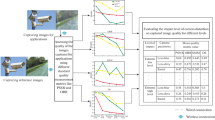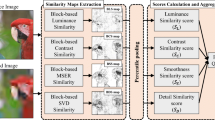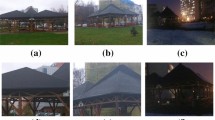Abstract
In recent years, computer vision applied in industrial application scenarios has been attracting attention. A lot of work has been made to present approaches based on visual perception, ensuring the safety during the processes of industrial production. However, much less effort has been done to assess the perceptual quality of corrupted industrial images. In this paper, we construct an Industrial Scene Image Database (ISID), which contains 3000 distorted images generated through applying different levels of distortion types to each of the 50 source images. Then, the subjective experiment is carried out to gather the subjective scores in a well-controlled laboratory environment. Finally, we perform comparison experiments on ISID database to investigate the performance of some objective image quality assessment algorithms. The experimental results show that the state-of-the-art image quality assessment methods have difficulty in predicting the quality of images that contain multiple distortion types.
Access this chapter
Tax calculation will be finalised at checkout
Purchases are for personal use only
Similar content being viewed by others
References
Gu, K., Zhang, Y., Qiao, J.: Ensemble meta-learning for few-shot soot density recognition. IEEE Trans. Industr. Inf. 17(3), 2261–2270 (2021)
Gu, K., **a, Z., Qiao, J., Lin, W.: Deep dual-channel neural network for image-based smoke detection. IEEE Trans. Multimed. 22(2), 311–323 (2020)
Li, L., Wang, G., Cormack, L., Bovik, A.C.: Efficient and secure image communication system based on compressed sensing for IoT monitoring applications. IEEE Trans. Multimed. 22(1), 82–95 (2020)
de Araujo, P.R.M., Lins, R.G.: Computer vision system for workpiece referencing in three-axis machining centers. Int. J. Adv. Manuf. Technol. 106, 2007–2020 (2020)
Kessler, M., Siewerdsen, J., Sonke, J.: Tu-C (SAM)-BRC-01: multimodality image acquisition, processing and display for guiding and adapting radiation therapy. Med. Phys. 38(6), 3751 (2011)
Gu, K., Tao, D., Qiao, J., Lin, W.: Learning a no-reference quality assessment model of enhanced images with big data. IEEE Trans. Neural Netw. Learn. Syst. 29(4), 1301–1313 (2018)
Gu, K., Zhai, G., Lin, W., Liu, M.: The analysis of image contrast: from quality assessment to automatic enhancement. IEEE Trans. Cybern. 46(1), 284–297 (2016)
Min, X., Ma, K., Gu, K., Zhai, G., Wang, Z., Lin, W.: Unified blind quality assessment of compressed natural, graphic, and screen content images. IEEE Trans. Image Process. 26(11), 5462–5474 (2017)
Min, X., Zhai, G., Gu, K., Yang, X., Guan, X.: Objective quality evaluation of dehazed images. IEEE Trans. Intell. Transp. Syst. 20(8), 2879–2892 (2019)
Min, X., et al.: Quality evaluation of image dehazing methods using synthetic hazy images. IEEE Trans. Multimed. 21(9), 2319–2333 (2019)
Gu, K., Zhai, G., Yang, X., Zhang, W.: Hybrid no-reference quality metric for singly and multiply distorted images. IEEE Trans. Broadcast. 60(3), 555–567 (2014)
Gu, K., Liu, M., Zhai, G., Yang, X., Zhang, W.: Quality assessment considering viewing distance and image resolution. IEEE Trans. Broadcast. 61(3), 520–531 (2015)
Gu, K., Wang, S., Zhai, G., Ma, S., Yang, X., Zhang, W.: Content-weighted mean-squared error for quality assessment of compressed images. Signal Image Video Process. 10(5), 803–810 (2015). https://doi.org/10.1007/s11760-015-0818-9
Di Claudio, E.D., Jacovitti, G.: A detail-based method for linear full reference image quality prediction. IEEE Trans. Image Process. 27(1), 179–193 (2018)
Gu, K., Zhai, G., Yang, X., Zhang, W.: A new reduced-reference image quality assessment using structural degradation model. In: Proceeding IEEE International Symposium on Circuits and Systems, pp. 1095–1098, May 2013
Liu, M., Gu, K., Zhai, G., LeCallet, P., Zhang, W.: Perceptual reduced-reference visual quality assessment for contrast alteration. IEEE Trans. Broadcast. 63(1), 71–81 (2017)
Mittal, A., Moorthy, A.K., Bovik, A.C.: No-reference image quality assessment in the spatial domain. IEEE Trans. Image Process. 21(12), 4695–4708 (2012)
Gu, K., Zhai, G., Yang, X., Zhang, W.: Using free energy principle for blind image quality assessment. IEEE Trans. Multimed. 17(1), 50–63 (2015)
Min, X., Gu, K., Zhai, G., Liu, J., Yang, X., Chen, C.: Blind quality assessment based on pseudo-reference image. IEEE Trans. Multimed. 20(8), 2049–2062 (2018)
Min, X., Zhai, G., Gu, K., Liu, Y., Yang, X.: Blind image quality estimation via distortion aggravation. IEEE Trans. Broadcast. 64(2), 508–517 (2018)
Sun, W., Min, X., Zhai, G., Gu, K., Duan, H., Ma, S.: MC360IQA: a multi-channel CNN for blind 360-degree image quality assessment. IEEE J. Sel. Top. Signal Process. 14(1), 64–77 (2020)
Wang, Z., Bovik, A.C.: Mean squared error: love it or leave it? A new look at signal fidelity measures. IEEE Signal Process. Mag. 26(1), 98–117 (2009)
Wang, Z., Bovik, A.C., Sheikh, H.R., Simoncelli, E.P.: Image quality assessment: from error visibility to structural similarity. IEEE Trans. Image Process. 13(4), 600–612 (2004)
Sheikh, H.R., Bovik, A.C.: Image information and visual quality. IEEE Trans. Image Process. 15(2), 430–444 (2006)
Chandler, D.M., Hemami, S.S.: VSNR: a wavelet-based visual signal-to-noise ratio for natural images. IEEE Trans. Image Process. 16(9), 2284–2298 (2007)
Mittal, A., Soundararajan, R., Bovik, A.C.: Making a completely blind image quality analyzer. IEEE Signal Process. Lett. 20(3), 209–212 (2013)
Gu, K., Zhai, G., Yang, X., Zhang, W.: No-reference quality metric of contrast-distorted images based on information maximization. IEEE Trans. Cybern. 47(12), 4559–4565 (2017)
Gu, K., Zhai, G., Lin, W., Yang, X., Zhang, W.: No-reference image sharpness assessment in autoregressive parameter space. IEEE Trans. Image Process. 24(10), 3218–3231 (2015)
ITU: Methodology for the subjective assessment of the quality of television pictures. Recommendation, International Telecommunication Union/ITU Ratio communication Sector (2009)
Li, L., Zhou, Y., Lin, W., Wu, J., Zhang, X., Chen, B.: No-reference quality assessment of deblocked images. Neurocomputing 177, 572–584 (2016)
Final report from the video quality experts group on the validation of objective models of video quality assessment VQEG, March 2000. http://www.vqeg.org/
Wang, Z., Simoncelli, E.P., Bovik, A.C.: Multiscale structural similarity for image quality assessment. In: Proceeding 37th Asilomar Conference on Signals, vol. 2, pp. 1398–1402, November 2003
Upadhyaya, V., Salim, M.: Compressive sensing based computed tomography Imaging: an effective approach for COVID-19 detection. Int. J. Wavelets Multiresolut. Inf. Process. 19, 2150014 (2021)
Liu, A., Lin, W., Narwaria, M.: Image quality assessment based on gradient similarity. IEEE Trans. Image Process. 21(4), 1500–1512 (2012)
Xue, W., Zhang, L., Mou, X., Bovik, A.C.: Gradient magnitude similarity deviation: a highly efficient perceptual image quality index. IEEE Trans. Image Process. 23(2), 684–695 (2014)
Gu, K., Zhai, G., Yang, X., Zhang, W.: An efficient color image quality metric with local-tuned-global model. In: Proceeding IEEE International Conference on Image Processing, pp. 506–510, October 2014
Zhang, L., Shen, Y., Li, H.: VSI: a visual saliency-induced index for perceptual image quality assessment. IEEE Trans. Image Process. 23(10), 4270–4281 (2014)
Appina, B., Dendi, S.V.R., Manasa, K., Channappayya, S.S., Bovik, A.C.: Study of subjective quality and objective blind quality prediction of stereoscopic videos. IEEE Trans. Image Process. 28(10), 5027–5040 (2019)
Gu, K., Li, L., Lu, H., Min, X., Lin, W.: A fast reliable image quality predictor by fusing micro- and macro- structures. IEEE Trans. Industr. Inf. 64(5), 3903–3912 (2017)
Gu, K., Zhou, J., Qiao, J., Zhai, G., Lin, W., Bovik, A.C.: No-reference quality assessment of screen content pictures. IEEE Trans. Image Process. 26(8), 4005–4018 (2017)
Ospina-Borras, J.E., Benitez-Restrepo, H.D.: Non-reference quality assessment of infrared images reconstructed by compressive sensing. In: Proceeding of SPIE the International Society for Optical Engineering, pp. 9396 (2015)
Friston, K., Kilner, J., Harrison, L.: A free energy principle for the brain. J. Physiol.-Paris 100, 70–87 (2006)
Friston, K.: The free-energy principle: a unified brain theory? Nat. Rev. Neurosci. 11, 127–138 (2010)
Zhu, W., et al.: Multi-channel decomposition in Tandem with free-energy principle for reduced-reference image quality assessment. IEEE Trans. Multimed. 21(9), 2334–2346 (2019)
Author information
Authors and Affiliations
Corresponding author
Editor information
Editors and Affiliations
Rights and permissions
Copyright information
© 2022 Springer Nature Singapore Pte Ltd.
About this paper
Cite this paper
Gong, Y., Peng, C., Liu, J., Zhou, C., Liu, H. (2022). Perceptual Quality Evaluation of Corrupted Industrial Images. In: Zhai, G., Zhou, J., Yang, H., An, P., Yang, X. (eds) Digital TV and Wireless Multimedia Communications. IFTC 2021. Communications in Computer and Information Science, vol 1560. Springer, Singapore. https://doi.org/10.1007/978-981-19-2266-4_15
Download citation
DOI: https://doi.org/10.1007/978-981-19-2266-4_15
Published:
Publisher Name: Springer, Singapore
Print ISBN: 978-981-19-2265-7
Online ISBN: 978-981-19-2266-4
eBook Packages: Computer ScienceComputer Science (R0)




